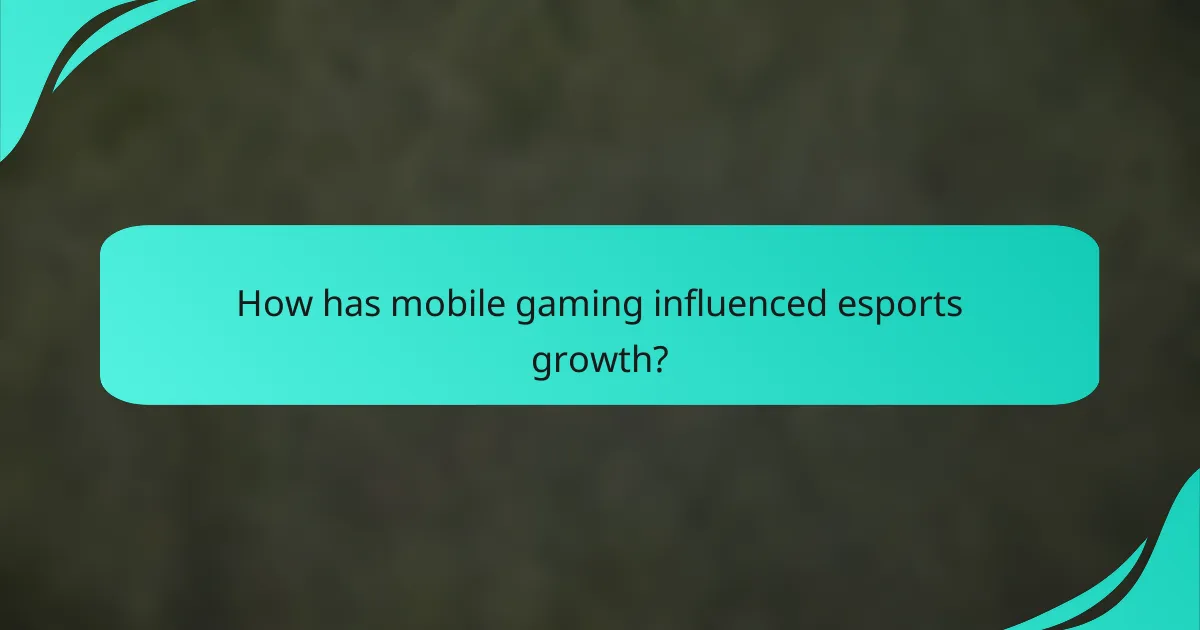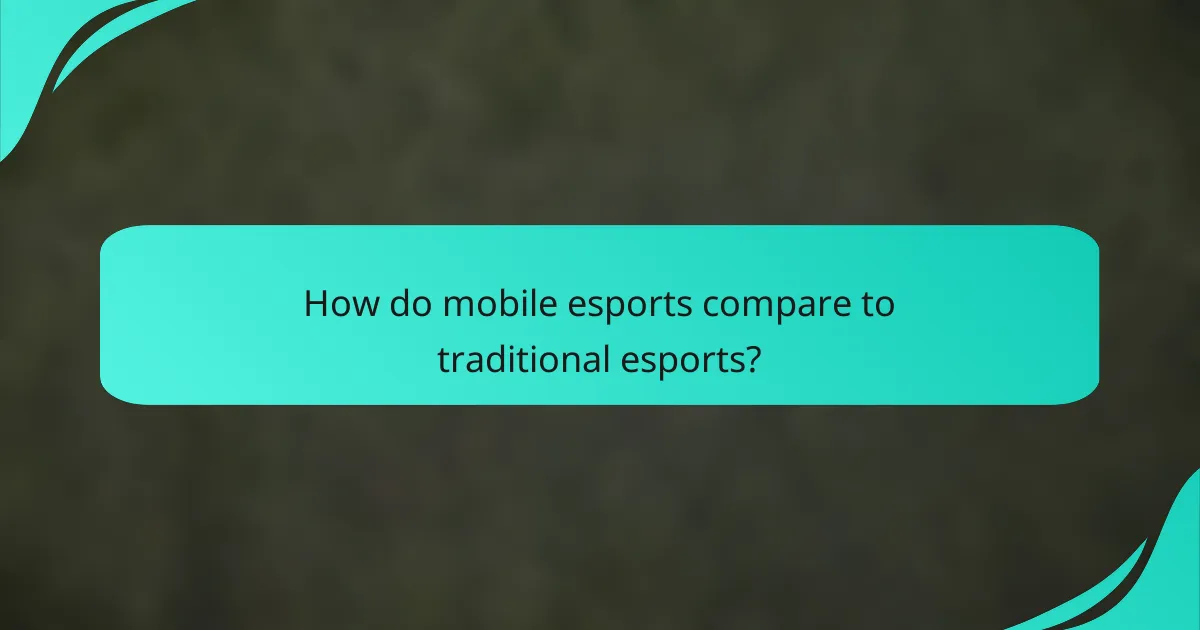Mobile gaming has transformed the esports landscape by enhancing accessibility and engagement for players and audiences alike. The evolution of mobile esports has been marked by significant milestones, including the launch of popular games and the establishment of dedicated tournaments and leagues. As trends continue to shift towards competitive formats and community involvement, mobile gaming is poised to play an increasingly vital role in the future of esports.

How has mobile gaming influenced esports growth?
Mobile gaming has significantly accelerated the growth of esports by making competitive gaming more accessible to a broader audience. With the rise of smartphones, players can engage in esports from virtually anywhere, leading to increased participation and viewership.
Increased accessibility for players
Mobile gaming has lowered the barriers to entry for aspiring esports players. Unlike traditional gaming setups that require expensive hardware, mobile games can be played on devices that many people already own, such as smartphones and tablets.
This accessibility allows more individuals to participate in competitive gaming, fostering a larger talent pool and encouraging grassroots movements within the esports community.
Expansion of player demographics
The rise of mobile gaming has diversified the demographics of esports participants. Players from various age groups, genders, and backgrounds now engage in competitive gaming, reflecting a broader representation than seen in traditional PC or console esports.
This expansion has led to a more inclusive environment, with games appealing to casual gamers and hardcore competitors alike, thereby increasing overall engagement in the esports ecosystem.
Rise of mobile esports tournaments
Mobile esports tournaments have surged in popularity, with numerous competitions dedicated solely to mobile titles. Events like the PUBG Mobile Global Championship and the Free Fire World Series attract millions of viewers and offer substantial prize pools, often reaching into the millions of USD.
These tournaments not only showcase top talent but also encourage new players to participate, further fueling the growth of mobile esports.
Integration with streaming platforms
Mobile gaming has seamlessly integrated with streaming platforms, enhancing visibility and engagement. Popular platforms like Twitch and YouTube Gaming host mobile game streams, allowing players to showcase their skills and connect with audiences in real-time.
This integration has created a vibrant ecosystem where mobile gamers can build communities, share strategies, and gain recognition, contributing to the overall growth of esports.
Partnerships with major brands
As mobile esports gain traction, partnerships with major brands have become increasingly common. Companies in various sectors, from technology to consumer goods, are sponsoring tournaments and teams, elevating the profile of mobile gaming.
These collaborations not only provide financial support but also enhance the legitimacy of mobile esports, attracting more players and viewers while creating new marketing opportunities for brands.

What are the key historical milestones in mobile esports?
Mobile esports has evolved significantly over the years, marked by several key milestones that have shaped its current landscape. These milestones include the launch of popular mobile games, the first mobile esports tournaments, major sponsorship deals, and the introduction of dedicated mobile esports leagues.
Launch of popular mobile games
The launch of popular mobile games has been a crucial factor in the rise of mobile esports. Titles such as “Clash Royale,” “PUBG Mobile,” and “Call of Duty: Mobile” have attracted millions of players globally, creating a competitive environment. These games often feature engaging mechanics and multiplayer capabilities, making them ideal for esports competitions.
As these games gained traction, they also fostered communities and fan bases, further enhancing the competitive scene. The accessibility of mobile devices allowed players from various backgrounds to participate, contributing to the growth of the esports ecosystem.
First mobile esports tournaments
The first mobile esports tournaments marked a significant turning point for the industry. Events like the “Clash Royale League” and “PUBG Mobile Global Championship” showcased the potential of mobile gaming in a competitive format. These tournaments not only provided a platform for players to demonstrate their skills but also attracted substantial viewership.
These early tournaments set the stage for future events, establishing standards for competitive play and organization. They highlighted the viability of mobile esports as a legitimate segment within the broader esports landscape.
Major sponsorship deals
Major sponsorship deals have played a pivotal role in the growth of mobile esports. Companies such as Samsung, Red Bull, and various telecommunications firms have invested in mobile gaming events and teams, providing financial support and resources. These partnerships have helped elevate the profile of mobile esports and attract more players and fans.
Such sponsorships not only enhance the quality of tournaments but also contribute to the overall sustainability of the mobile esports ecosystem. They enable organizers to offer larger prize pools and better production values, which in turn attracts more participants and viewers.
Introduction of mobile esports leagues
The introduction of mobile esports leagues has further solidified the competitive structure of mobile gaming. Leagues like the “Mobile Legends: Bang Bang Professional League” and “Free Fire Pro League” provide regular competitive play, allowing teams to compete over extended seasons. This format fosters rivalries and enhances viewer engagement.
These leagues often feature structured formats, including regular seasons, playoffs, and championships, which help maintain interest and excitement among fans. They also provide players with consistent opportunities to showcase their skills and earn recognition in the mobile esports community.

What are the current trends in mobile gaming and esports?
Current trends in mobile gaming and esports highlight the rapid evolution of gameplay experiences, particularly through the rise of competitive formats and community engagement. Key developments include the popularity of battle royale games, increased streaming of mobile games, and the emergence of cross-platform play, all contributing to a dynamic gaming landscape.
Growth of battle royale games
Battle royale games have surged in popularity, attracting millions of players worldwide. Titles like PUBG Mobile and Fortnite have set the standard, offering intense, last-player-standing gameplay that keeps users engaged. These games often feature seasonal updates and in-game events to maintain player interest and foster community interaction.
Developers are increasingly focusing on mobile adaptations of successful PC and console battle royale games, optimizing controls and graphics for mobile devices. This trend has led to significant revenue growth, with in-game purchases becoming a key monetization strategy.
Increased mobile game streaming
Mobile game streaming has gained traction, with platforms like Twitch and YouTube Gaming showcasing mobile esports events and individual gameplay. Streamers often attract large audiences, providing entertainment and fostering community engagement. This trend has made mobile gaming more accessible and visible to a broader audience.
As mobile devices become more powerful, the quality of streamed content improves, allowing for smoother gameplay and higher resolution. Gamers looking to enter this space should focus on building a unique brand and engaging with their audience through regular content updates and interactive streams.
Emergence of cross-platform play
Cross-platform play is becoming a standard feature in mobile gaming, allowing players on different devices to compete against each other. This trend enhances the gaming experience by broadening the player base and creating more competitive environments. Games like Call of Duty: Mobile and Fortnite support cross-platform functionality, enabling seamless interaction between mobile, console, and PC players.
For developers, implementing cross-platform play can increase user retention and engagement, as players can connect with friends regardless of their device. However, balancing gameplay across platforms remains a challenge, requiring careful consideration of controls and performance to ensure fairness.

What are the challenges facing mobile esports?
Mobile esports face several challenges that can hinder their growth and competitiveness. Key issues include device fragmentation, network connectivity problems, and regulatory hurdles that vary by region.
Device fragmentation
Device fragmentation refers to the wide variety of mobile devices available, each with different specifications and performance capabilities. This inconsistency can affect game performance and player experience, as not all devices can run games smoothly or at the same quality level.
Developers must optimize their games for numerous screen sizes, operating systems, and hardware configurations. This can lead to increased development costs and longer timelines, as they strive to ensure compatibility across a broad range of devices.
Network connectivity issues
Network connectivity is crucial for mobile esports, as stable and fast internet connections are necessary for competitive play. However, many players may experience latency or disconnections due to poor network infrastructure, especially in rural or underserved areas.
To mitigate these issues, players should consider using wired connections where possible, or investing in mobile data plans with reliable coverage. Game developers can also implement features that allow for offline play or lower bandwidth requirements to enhance accessibility.
Regulatory hurdles
Regulatory hurdles can significantly impact the growth of mobile esports, as different countries have varying laws regarding gaming, gambling, and online competitions. These regulations can affect sponsorships, prize distributions, and even the legality of certain games.
Esports organizations must navigate these complexities to ensure compliance with local laws. This may involve working with legal experts and adapting their business models to meet regulatory requirements, which can be a time-consuming and costly process.

How do mobile esports compare to traditional esports?
Mobile esports differ from traditional esports in several key aspects, including gameplay mechanics, audience demographics, and accessibility. While traditional esports often focus on PC or console games, mobile esports leverage the ubiquity of smartphones, allowing a broader audience to participate and engage.
Differences in audience engagement
Audience engagement in mobile esports tends to be more dynamic due to the accessibility of mobile devices. Players can easily join games and tournaments from anywhere, leading to a more spontaneous and diverse player base. This flexibility often results in higher participation rates compared to traditional esports, where players may need specific hardware and setups.
Moreover, mobile esports often utilize social media and streaming platforms to enhance viewer interaction. For example, platforms like Twitch and YouTube Gaming allow fans to engage with content creators and teams in real-time, fostering a community atmosphere that can be less prevalent in traditional esports.
However, the engagement metrics can vary significantly. Mobile esports may attract a younger audience, often in the age range of 15-25, while traditional esports might appeal more to older gamers, typically between 18-35. Understanding these demographics can help brands and sponsors tailor their marketing strategies effectively.
